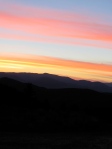Day 26-27
Sep 24-25. 2010
Miles 2793 – 3403
Bozeman, MT to Lewiston, ID
Lewis and Clark’s Corps of Discovery moved fairly quickly across the plains after leaving Fort Mandan in the spring of 1805. That is, they had some struggles as their men towed the boats upriver over increasingly rocky shores, and frequent encounters with grizzly bears tested their courage, but those trials were nothing to what was to come. They had been told that portaging around the Missouri River’s Great Falls would take half a day – in fact it took them more like half a month. From there, the Missouri turned southward, carving its valley through the eastern foothills of the Rocky Mountains, and the expedition’s course took them through high, arid plains.
I didn’t go all the way up to Great Falls (this time), but I met back up with the river to the west of Bozeman, in Three Forks, MT. There, between the Bridger and Tobacco Root Mountains, the Missouri is born. The Jefferson, Madison, and Gallatin Rivers come together from the south, and merge their waters into the clear river that gets named The Big Muddy farther downstream. One thing that I’ve learned on this trip is that, while geology may determine the course of waterways, it is humanity that decides their geography. Why is this point considered the headwaters of the great Missouri River? There may be geological clues that sway the geographers, but ultimately it was William Clark who drew the map as we see it today. He could have omitted one of those smaller rivers and taken the Missouri all the way up into the mountains to the south. The same questions arose with the naming of the Mississippi. The great river that empties into the Gulf of Mexico is considered to have its roots a couple hundred miles from the Canadian border… but only because explorers decided to follow that branch with that name. Why isn’t the St. Croix, or the Ohio or, for that matter, the Missouri, the one that is considered to terminate at the ocean, rather than being a mere

This was named Beaverhead Rock by the Snake Indians, and was an important landmark for natives and early explorers alike.
tributary? Because someone said so, that’s why.
Regardless of names, I continued along Lewis and Clark’s approximate route up Jefferson’s River to the south, and thence to the Beaverhead and Red Rock Rivers. This was the plain of Sacagawea’s Snake Indian relatives – a wide and grassy valley with steep slopes on either side. Today’s highway closely approximates their trail… though Clark’s return 1806 route on the Big Hole River was better than their outbound route – and the size and condition of the roadway reflect that. I, however, followed the 1805
outbound trail, crossing the continental divide at Lemhi Pass in the Bitterroot Mountains. I reached the summit at sunset, and descended into Idaho’s Lemhi Valley in darkness. The smells of sage and pine permeated the air, and as I reached the bottom of the twisted gravel road, I could hear the 
roaring of the Lemhi River.
The following day was one of hard driving for me – but nothing to the Corps’ months of struggle in crossing these mountains. I headed north up the Salmon River valley to yet another crossing of the Bitterroot Mountains at Lost Trail Pass, descending back into Montana’s Bitterroot. This is a broad valley, suitable for some habitation in Lewis and Clark’s day and plenty of towns spilling south from Missoula today. After heading north for nearly 100 miles, their trail and mine turn to the west, and we head up into the final pass of this tortuous journey (for my part, the only exertion has been on my right ankle, alternating between the gas and brake pedals… I feel a little wimpy). I cross Lolo Pass back into Idaho (my third trip across the continental divide in 24 hours – but nothing compared to three months!) and begin the winding descent along the Lochsa and Clearwater Rivers. It is beautiful!











